Published on April 1, 2025.
- Real-Time Coliform Sensor Pilot Study Part I
- Regional Shellfish Meeting Highlight Critical Management Issues
- A Peak into Vibrio Parahaemolyticus Monitoring in 2023
- Aquaculture Division Utilizes ROV for Site Assessments
- A Tropical Display from a North Atlantic Native
Real-Time Coliform Sensor Pilot Study Part I
By Amy Webb, Microbiologist
The Maine Department of Marine Resources (DMR) closes Maine waters to shellfish harvesting where elevated fecal coliform/thermotolerant bacteria are present. Staff collects water samples by land and boat along Maine's coastline from Kittery to the Canadian border. The water samples are then transported to one of two DMR labs. Back at the lab, the sample gets filtered onto a filter paper with a mesh size small enough to capture the bacteria present in the water (Fig 1). The filter papers are then transferred to culture plates that contain a specialized growth media that facilitates the growth of thermotolerant bacteria while inhibiting the growth of other non-thermotolerant bacteria using temperature (APHA, 1992; USEPA, 1985). The culture undergoes a 2-hour recitation period then the plates are incubated under specific temperature conditions for 24 hours. After incubation, the plates are examined and colonies of thermotolerant bacteria (such as E. coli), which are visually evident on the filter papers, are counted and reported (Fig 2). These colony forming unit (CFU) values are used, in part, to classify and monitor the water quality of the growing areas.
The filtration of water samples to analyze thermotolerant bacteria can be a lengthy, expensive and labor-intensive process. Sensors for real-time monitoring of different parameters of water quality such as dissolved oxygen, pH, turbidity, etc. are constantly being developed, however having the ability to monitor coliforms (total and fecal) in real-time with a sensor is a novel idea. There is currently a sensor out there that records real-time viable microbial data (total coliform, E. coli and fecal coliform) using a combination of tryptophan-like fluorescence (TLF), turbidity, a thermistor, and a robust data correction algorithm. With this sensor, thermotolerant bacteria can be detected and quantified within seconds (in theory). Having access to a sensor that can produce instantaneous fecal coliform data could be another tool in our fecal coliform “toolbelt” to assist with finding and tracking pollution issues and sources.
The Bureau of Public Health and Aquaculture was awarded grant funding from the Maine Outdoor Heritage Fund to purchase a real-time coliform sensor that will be used to determine if a real-time coliform sensor is fit for purpose in assisting the Bureau with tracking and/or monitoring the amount of bacterial contamination in shellfish growing area water and to assist with weekly monitoring of aquarium touch tanks. The goal of this pilot study is to compare the current NSSP standardized membrane filtration method (for growing area water) to the results obtained with the real-time Proteus sensor, i.e. “how accurate is this sensor”?
The lab received the Proteus sensor over the Spring of 2024 when Phase 1 of this pilot study was initiated: onsite training of key staff members and conducting site specific calibrations to increase accuracy and precision of coliform measurements. Staff members have been performing calibrations, collecting water samples, learning how to operate the different features of the sensor and thinking about best sampling practices.
Look for the next Public Health and Aquaculture Newsletter to read about Phase 2 of this pilot study: collecting growing area water samples along Maine's coastline and comparing the sensor results to the current filtration method, will they be similar?
“This project was funded in part by the Maine Outdoor Heritage Fund, in which proceeds from the sale of a dedicated instant lottery ticket currently (fill in current ticket) are used to support outdoor recreation and natural resource conservation. For more information about MOHF, go to www.maine.gov/ifw/mohf”
References:
APHA. 1992. Standard methods for the examination of water and wastewater. 18th ed. American Public Health Association, Washington, DC.
USEPA. 1985. Test methods for Escherichia coli and enterococci in water by the membrane filter procedure (Method #1103.1). EPA 600/4-85-076. U.S. Environmental Protection Agency, Environmental Monitoring and Support Laboratory, Cincinnati, OH.
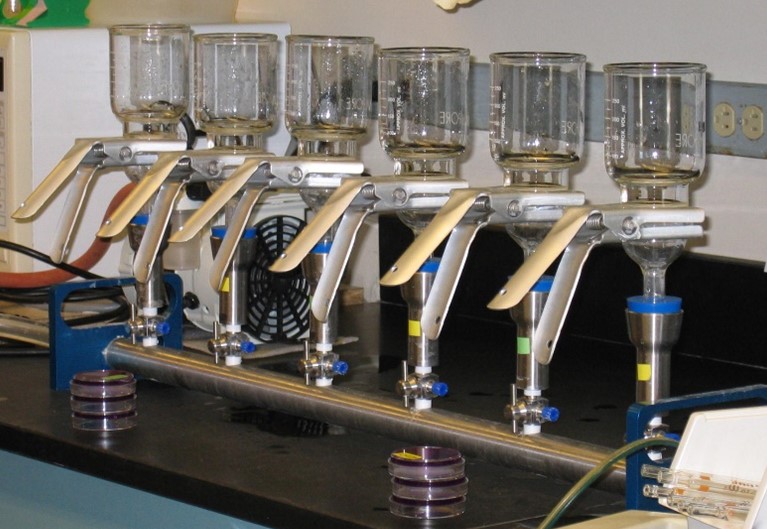


Regional Shellfish Meeting Highlight Critical Management Issues
By Hannah Annis, Ari Leach, and Heidi Leighton, Nearshore Marine Resource Scientists
The Nearshore Marine Resources Program hosted Regional Shellfish Meetings at the beginning of December. Meetings were held in each of the three regional shellfish management areas of the coast: Southern (Brunswick), Central (Belfast), and Eastern (Machias). The goal of these meetings was to provide an in-person, accessible, interactive opportunity for municipal officials, harvesters, and shellfish committee members to talk with each other as well as DMR staff. Each meeting venue featured topics critical to shellfish management, from shellfish reseeding projects to completing Army Corps permits to trapping green crabs, among others.
At the regional meetings, Nearshore scientists presented the results of an analysis of the 2023 Annual Shellfish Management Review reports. Annual Review reports are one of the requirements of having a municipal shellfish program, providing a platform for programs to evaluate their efforts during the year as well as to plan for future management goals and conservation activities. Data from the 2023 Annual Review reports were summarized to the historical coastwide level; and further examined to the regional level in some cases. Analyzing and summarizing the information from these reports helps DMR to determine if shellfish programs are meeting requirements as well as providing a better understanding of local effort. The DMR report includes Annual Review submissions from 58 shellfish programs encompassing over 70 municipalities. The 58 shellfish programs are separated into the three coastal regions. Summarizing the Annual Review data to the coastwide level provided interesting information, but analyzing the data down to the regional level provided even greater insight into effort and highlighted geographical differences. Some of the more interesting regional information such as multispecies management and a summary of municipal shellfish license fees did not originate from the Annual Review report, but rather from individual shellfish ordinances and the 2023 DMR annual license allocation approval letters. The process of reviewing and summarizing the data also indicated that updating the Annual Review submission documents would make the data collected more relevant and valuable to DMR and municipal shellfish programs. The entire 2023 Annual Review Summary Report is available online.
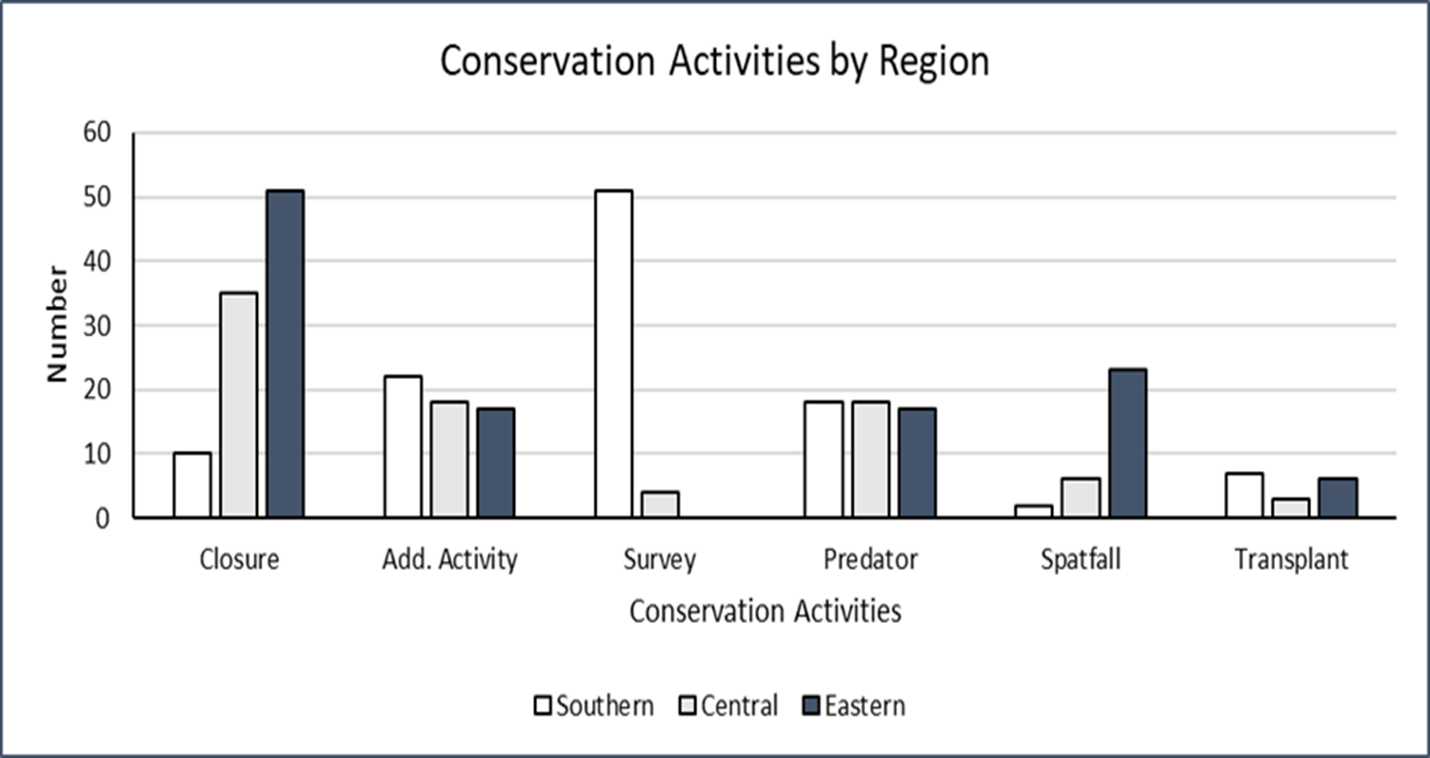

A Peak into Vibrio Parahaemolyticus Monitoring in 2023
By Aidan Lurgio, Shellfish Inspector
Shellfish aquaculture is expanding in Maine’s coastal waters. The Eastern oyster (Crassostrea virginica) is a dominant commercial species in the US and found along the Atlantic and Gulf coast. In 2023, landed oysters were valued at 10 million dollars making them one of Maine's most valuable species (DMR 2023). Oysters, like all molluscan bivalves, are filter feeders, bioaccumulating microorganisms found in the water column within their tissues. The potential human pathogen, Vibrio parahaemolyticus (Vp) is naturally occurring in marine environments and can cause gastroenteritis when consumed and is commonly associated with raw shellfish consumption. Typically, clinical strains causing gastroenteritis contain the tdh and trh genes. Oysters can accumulate bacteria like Vp 100-fold higher than the surrounding water (Almuhaideb et al., 2020). Abundant Vp biomass is associated with water temperatures above 19°C (66°F) with a salinity range of 10-34 psu and ideal levels between 20-30 psu (Martinez-Urtaza et al., 2010, Lovell., 2017). As the Gulf of Maine warms, the seasonal and geographic range of Vp may expand which could negatively impact the shellfish industry. Vp related illnesses have been increasing in ME with reported illnesses doubling from 2022 to 2023 (Figure 1) and our first ever Vibrio outbreak in 2023 resulting in a growing area closure. To prepare for future closures and understand the seasonality of Vp in Maine coastal waters, we collected the baseline levels of Vp in oysters from three growing areas (Scarborough River, Maquoit Bay, and Damariscotta River) and used generalized additive models to analyze their response to sea surface temperatures and salinity levels from May – November 2023.
Oysters were analyzed using the FDA approved 3 – tube MPN to determine total Vp (tlh) and potentially pathogenic Vp (tdh and trh) (Kinsely et al., 2015). Eighty-seven samples were processed using qPCR, and the mean of each triplicate sample was used for analysis (Figure 2). Hobo temperature loggers were deployed at each site for the season and immediate temperature and salinity values were taken using a YSI meter at the time of each sample (Figure 3).
The Gulf of Maine is one of the fastest warming saltwater bodies on the planet, which impacts the oyster industry. Data collected in accordance with the FDA approved methods can be used for regulatory action and routine monitoring of this pathogen and can help inform the industry and minimize illnesses. Results support the need for a statewide Vp plan and the risks of temperature abuse during harvesting and processing of oysters due to the presence of potentially pathogenic Vp strains. Understanding baseline Vp levels is beneficial as the state monitors illnesses, evaluates growing areas, and responds to closures.
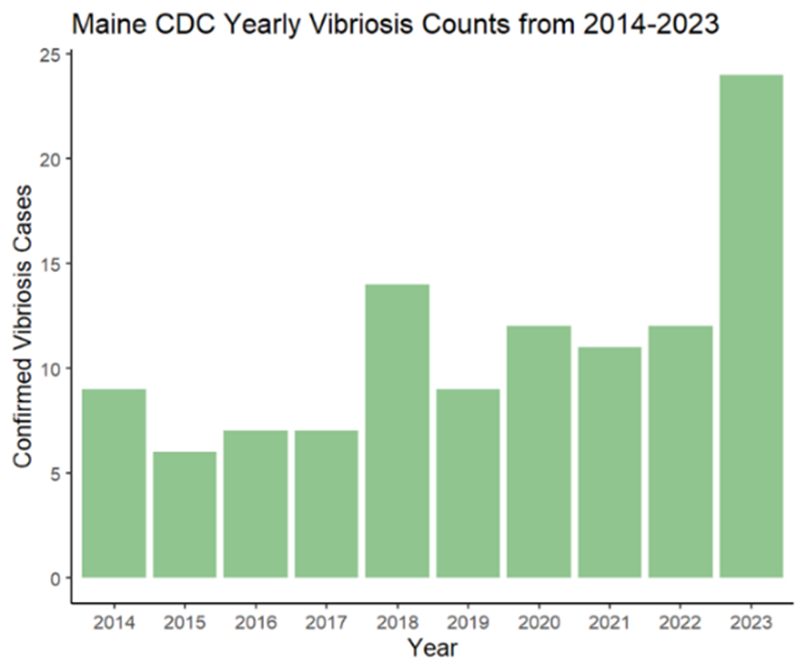
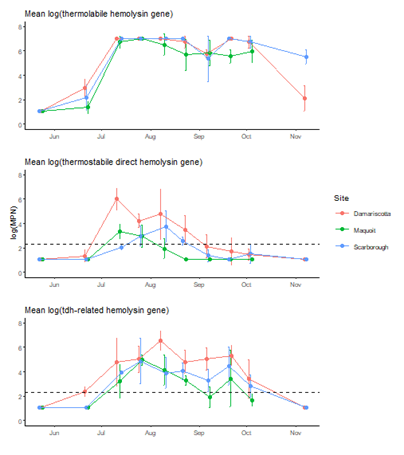
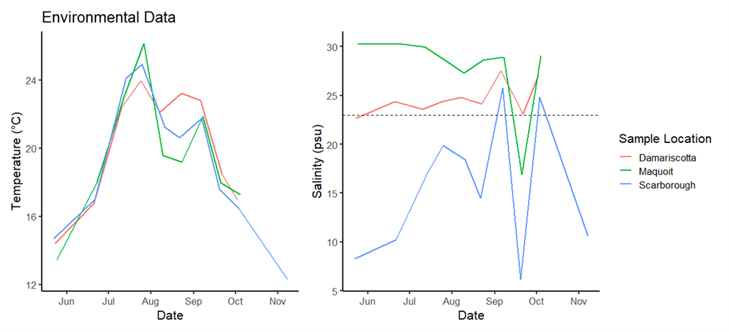
Aquaculture Division Utilizes ROV for Site Assessments
By Meryl Grady, Lead Scientist Aquaculture Division
The DMR Aquaculture Division is required to conduct a site assessment for proposed standard and experimental lease sites. DMR also has the discretion to conduct a site assessment for proposed standard lease expansions. Statute and regulation specify the elements DMR is required to document during the site assessment, including bottom composition, water depth and features, typical flora and fauna, relative abundance of commercial and recreational species, evidence of fishing activity, distances to shore, and navigation channels and moorings.
In order to document all required information, staff utilize a variety of equipment, such as transom-mounted depth sounders, GPS devices, or more recently, a remotely operated vehicle (ROV). In 2023, the Aquaculture Division began utilizing an ROV during site assessments to aid in collecting necessary information. Currently, staff use one of two methods to collect underwater video footage at a proposed site; staff may SCUBA dive with a GoPro camera or use a ROV to assess bottom composition and other considerations.
The addition of the ROV to our toolbelt has provided both flexibility and program enhancement. When compared to SCUBA, the ROV requires fewer staff to operate (two for ROV, three for SCUBA), it is more time-efficient, the live footage allows for additional investigation on-the-spot, and it can access more locations than we can with SCUBA, such as under aquaculture gear and in very shallow or very deep water. The ROV can be operated from a vessel or land-based (images below).
The ROV has been a great addition to our team and we are looking forward to continuing to use it.
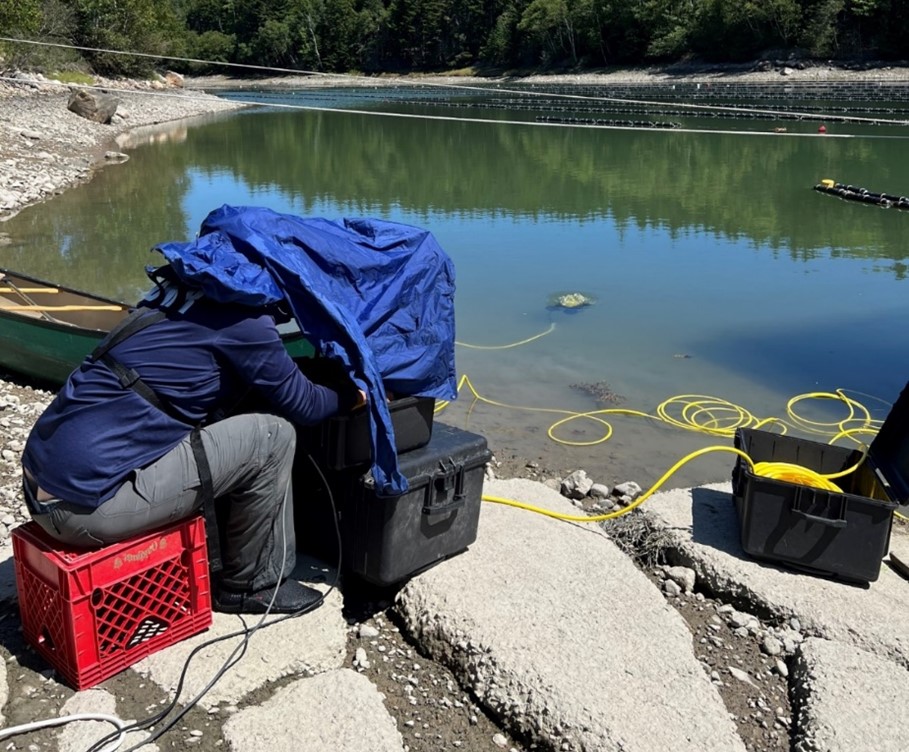

A Tropical Display from a North Atlantic Native
By Brianna King, Microbiologist II
This summer Somes Sound, a fjord located off Mount Desert Island, saw a unique display of colors, reminiscent of bright turquoise waters found in coastal regions located much further south than the Gulf of Maine. These opaque, blue-green waters stretched over the majority of the Sound and piqued the interest of many locals and visitors alike. Citizens aware of the Gulf of Maine’s annual harmful algal blooms, which can pose significant public health concerns, alerted DMR of the oddly colored waters and we went out to investigate.

Based on water samples that were examined under a light microscope, an identification of the phytoplankton responsible for the bloom was confirmed. The waters of Somes Sound were experiencing a localized bloom of coccolithophores! The blue-green milky hue to the water alone pointed to these particular phytoplankton, which make their shells or “armor” out of calcium carbonate. That’s right, these little single-celled critters have their own armor made out of intricate overlapping scales (formally called coccoliths). There are many species of coccolithophores, each producing its own unique patterned scales, some more gaudy than others. When a large number of coccolithophore cells are present in the surface waters, the light reflecting off of the calcium carbonate scales leads to a whitish or turquoise hue.
Right: Scanning electron microscope image of a coccolithophore cell, courtesy of Steve Gschmeissner, Science Photo Library.
Coccolithophores are found throughout the world’s oceans and are certainly no strangers to the Gulf of Maine. They likely exist as part of the overall phytoplankton community at any given time, though dense coastal blooms like the one covering Somes Sound are not highly common occurrences here. Offshore blooms of these phytoplankton can be more common and can reach sizes easily detectable by satellite imagery. This summer, NASA tracked a suspected coccolithophore bloom that had originated off the coast of Greenland beginning in May and persisting through at least mid-June. If these were coccolithophores that they were seeing from the satellite images, perhaps this bloom was related to the one witnessed in our backyard!
While coccolithophores do not produce any known toxins that negatively affect human health, dense phytoplankton blooms of any species have the potential to cause localized issues for the ecosystem, such as low dissolved oxygen levels that can result in fish die-offs. However, evidence of any negative ecological impacts from this relatively short-lived bloom were not observed. In fact, blooms of coccolithophores can offer potential positive impacts to the local environment. The calcium carbonate scales of these organisms can serve as a natural buffer, dissolving under certain conditions and helping to counter-act ocean acidification on a very localized level. These same scales also serve as an excellent carbon sink. When the coccolithophores die, their scales sink through the water column and eventually become buried in the sediment, effectively sequestering the carbon used by the organism to make them.
Phytoplankton are a very important part of the coastal and open ocean ecosystems and a healthy system typically has a diverse range of species present at any given time. While some species can become nuisances or pose significant dangers to humans and animals, far more species of phytoplankton are inherently harmless and serve unique and interesting roles within the system, like coccolithophores. In the future, the Gulf of Maine is likely to see new species of phytoplankton becoming more common in our waters, so it’s important to stay vigilant and to take note when our backyard exhibits changes or uncommon characteristics, like in the case of Somes Sound this summer.
